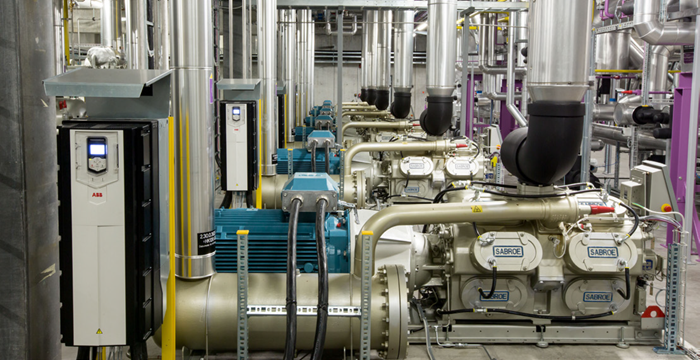Although there are substantial efficiency improvements to be gained through motor upgrades, even greater energy savings are possible when a high-efficiency motor is paired with a variable-speed drive.
A variable-speed drive is used to control an electric motor to optimize its operation. This is accomplished by adjusting the speed and torque of a motor during operation to match the system’s load requirements. With the right drive, an electric motor runs only as fast as required by the load, resulting in notable power savings.
Drives control the speed of an AC motor by varying the frequency and voltage of the power supplied to it. The earliest drives, developed in the early 20th century, were mechanical in design.


The numbers in this example are based on 60 % nominal design flow. Image Credit: ABB Motors and Drives North America
As solid-state electronics have advanced in recent decades, drives have become more sophisticated and cost-effective. Despite these improvements, adoption has been modest.
It is estimated that 23 % of global industrial motors are currently equipped with a variable-speed drive.15 That figure is expected to increase to 26 % over the next five years. However, greater savings could be achieved if the adoption rate were higher. Industry experts suggest that around 50 % of industrial motors would benefit from being paired with a drive.16
Without a drive, many motors operate at full speed, even when load requirements are low. In pumping applications, for example, a method known as “throttling” is used to control mechanical power, similar to slowing a car by applying the brakes without easing off the accelerator. This leads to wasted energy.
When added to existing pump, fan, or compressor motors, a variable-speed drive can typically reduce power consumption by 25 %17
The Impact of Digitalization and Connectivity
Another technological advancement that can improve the efficiency of electric motors is digitalization and connectivity—the industrial Internet of Things. By attaching wirelessly connected sensors to existing motors, performance can be monitored remotely and in real time.
In complex industrial setups or large building HVAC systems, this data can support process optimization and lead to significant energy savings.
When motors equipped with sensors are controlled by variable-speed drives, they become smart motors—capable of being controlled remotely or automatically. This further improves performance and energy efficiency. Data from the sensors, along with other system data, can be analyzed and used by a central control system for real-time adjustments across the installation.
Potential Benefits and the Way Forward
It is estimated that replacing the more than 300 million industrial electric motor-driven systems currently in use with optimized, high-efficiency equipment could reduce global electricity consumption by up to 10 %.18
These potential gains are substantial.19 However, practical challenges must be addressed to achieve them.
Regulatory policies are among the primary drivers of industrial investment in energy efficiency, particularly those implemented by large producers such as China, Europe, India, and the United States. Well-designed rules and incentives can support the broader adoption of high-efficiency motor technologies.
Another key factor is payback periods, as energy efficiency investments must compete with other financial opportunities.20 Motors and drives are often attractive investments due to their ease of installation, typically not requiring changes to existing industrial systems.
However, the payback period is closely tied to energy prices. When prices are high, investment in efficient equipment tends to rise. At present, financial incentives are not sufficient to accelerate adoption.
Nonetheless, deploying more drives and newer electric motor designs offers a strong opportunity as global efforts continue to improve energy efficiency. Gains from energy efficiency improvements are projected to deliver over 40 % of the greenhouse gas emissions reductions needed by 2040 to meet the targets of the Paris Agreement.21

Image Credit: ABB Motors and Drives North America

This information has been sourced, reviewed and adapted from materials provided by ABB Motors and Drives North America.
For more information on this source, please visit ABB Motors and Drives North America.